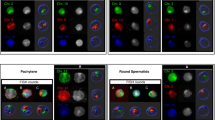Abstract
Sites for pairing and segregation of achiasmatic bivalents have been characterized in both male and female meiosis inDrosophila melanogaster. The major sex chromosome pairing site in male meiosis corresponds to the intergenic spacer repeats of the rDNA arrays, which are located in the heterochromatin of theX andY. The sex chromosome pairing sites in females are also heterochromatic, but involve different repeated sequences. In males, weak pairing sites are widely distributed along euchromatin but not heterochromatin of chromosome2, an autosome. One strong site for male meiotic pairing has been identified on chromosome2; it overlaps with thehis locus, which contains the repetitive structural genes for the histones. In females the sites for pairing of chromosome4, another autosome, are restricted to the heterochromatin. Thus for both sex chromosomes and autosomes, sites for achiasmatic pairing are heterochromatic in females but euchromatic (except for the rDNA) in males. The possible roles of sequence repetition and of transcription in chromosome pairing are discussed.
Similar content being viewed by others
References
Appels R, Hilliker AJ (1982) The cytogenetic boundaries of the rDNA region within heterochromatin of the X chromosome ofDrosophila melanogaster and their relation to male meiotic pairing sites. Genet Res 39:149–156
Ault JG, Rieder CL (1994) Meiosis inDrosophila males. I. The question of separate conjunctive mechanisms for the XY and autosomal bivalents. Chromosoma 103:352–356
Ault JG, Lin HP, Church K (1982) Meiosis inDrosophila melanogaster. IV. Conjunctive mechanism of the XY bivalent. Chromosoma 86:309–317
Bishop DK, Park D, Xu L, Kleckner N (1992)DMCl: a meiosis-specific yeast homolog ofE. coli RecA required for recombination, synaptonemal complex formation and cell-cycle progression. Cell 69:439–456
Camerini-Otero RD, Hsieh P (1995) Homologous recombination proteins in prokaryotes and eukaryotes. Annu Rev Genet 29:509–552
Cooper KW (1964) Meiotic conjunctive elements not involving chiasmata. Proc Natl Acad Sci USA 52:1248–1255
Gershenson S (1933) Studies on the genetically inert region of the X chromosome ofDrosophila: I. Behavior of an X chromosome deficient for a part of the inert region. J Genet 28:297–312
Hawley RS, Irick H, Zitron AE, haddox DA, Lohe A, New C, Whitley MD, Arbel T, Jang J, McKim K, Childs G (1993) There are two mechanisms of a chiasmate segregation inDrosophila females, one of which requires heterochromatic homology. Dev Genet 13:440–467
Hilliker AJ, Holm DG, Appels R (1982) The relationship between heterochromatic homology and meiotic segregation of compound second autosomes during spermatogenesis inDrosophila melanogaster. Genet Res 39:157–168
Jones GH (1987) Chiasmata. In: Kucherlapati R, Smith GR (eds) Genetic recombination. American Society for Microbiology, Washington DC, pp 213–238
Kremer H, Hennig W, Kijkhof R (1986) Chromatin organization in the male germ line ofDrosophila hydei. Chromosoma 94:147–161
Lindsley DL, Sandler L (1958) The meiotic behavior of grossly deleted X chromosomes inDrosophila melanogaster. Genetics 43:547–563
Lindsley DL, Edington CW, von Halle ES (1960) Sex-linked recessive lethals inDrosophila whose expression is suppressed by the Y chromosome. Genetics 45:1649–1670
Lindsley DL, Appels R, Hilliker AJ (1982)In(1)sc v2 subdivides the ribosomal DNA. Dros Inform Serv 58:99
Lohe AR, Roberts PA (1990) An unusual Y chromosome ofDrosophila simulans carrying amplified rDNA spacer without rRNA genes. Genetics 125:399–406
Lohe AR, Hilliker AJ, Roberts PA (1993) Mapping simple repeated DNA sequences in heterochromatin ofDrosophila melanogaster. Genetics 134:1149–1174
Long EO, David IB (1980) Repeated genes in eukaryotes. Annu Rev Biochem 49:727–764
McKee BD, Karpen GH (1990)Drosophila ribosomal RNA genes function as an X-Y meiotic pairing site during male meiosis. Cell 61:61–72
McKee BD, Lindsley DL (1987) Inseparability of X heterochromatic functions responsible for X:Y pairing, meiotic drive and male fertility inDrosophila melanogaster males. Genetics 116:399–407
McKee BD, Habera L, Vrana JA (1992) Evidence that intergenic spacer repeats ofDrosophila melanogaster rRNA genes function as X-Y pairing sites in male meiosis, and a general model of achiasmatic pairing. Genetics 132:529–544
McKee BD, Lumsden SE, Das S (1993) The distribution of male meiotic pairing sites on chromosome 2 ofDrosophila melanogaster: meiotic pairing and segregation of 2-Y transpositions. Chromosoma 102:180–194
Merrill CJ, Chakravarti D, Habera L, Das S, Eisenhour L, McKee BD (1992) Promoter-containing ribosomal DNA fragments function as X-Y meiotic pairing sites inD. melanogaster males. Dev Genet 13:468–484
Meyer GF (1960) The fine structure of spermatocyte nuclei ofDrosophila melanogaster. In: Houwink AL, Spit BJ (eds) Proceedings of the European regional conference on electron microscopy, Delfft, The Netherlands. Die Nederlandse Vereniging voor Electronmicroscopic Delfft, pp 951–954
Murphy TD, Karpen GH (1995) Interactions between the nod+ kinesin-like gene and extracentromeric sequences are required for transmission of aDrosophila minichromosome. Cell 81: 139–148
Murtif VL, Rae PMM (1985) In vivo transcription of rDNA spacers inDrosophila. Nucleic Acids Res 13:3221–3239
Nurminsky DK, Shevelyov YY, Nuzhdin SV, Gvozdev VA (1994) Structure, molecular evolution and maintenance of copy number of extended repeated structures in the X-heterochromatin ofDrosophila melanogaster. Chromosoma 103:277–285
Park H-S, Yamamoto M-T (1995) The centric region of the X chromosome rDNA functions in male meiotic pairing inDrosophila melanogaster. Chromosoma 103:700–707
Peacock WJ (1965) Nonrandom segregation of chromosomes inDrosophila males. Genetics 51:573–583
Ritossa F (1976) The bobbed locus. In: Ashburner M, Novitski E (eds) Genetics and biology ofDrosophila melanogaster, vol 1b. Academic Press, New York, pp 801–846
Sandler L, Braver G (1954) The meiotic loss of unpaired chromosomes inDrosophila melanogaster. Genetics 39:365–377
Wettstein D von, Rasmussen SW, Holm PB (1984) The synaptonemal complex in genetic segregation. Annu Rev Genet 18:331–414
Wu T-C, Lichten M (1994) Meiosis-induced double strand break sites determined by yeast chromatin structure. Science 263:515–518
Yamamoto M (1979) Cytological studies of heterochromatin function inDrosophila melanogaster males: autosomal meiotic pairing. Chromosoma 72:293–328
Yamamoto M, Miklos GLG (1977) Genetic dissection of heterochromatin inDrosophila: the role of basal X heterochromatin in meiotic sex chromosome behavior. Chromosoma 60:283–296
Author information
Authors and Affiliations
Rights and permissions
About this article
Cite this article
McKee, B.D. The license to pair: Identification of meiotic pairing sites inDrosophila . Chromosoma 105, 135–141 (1996). https://doi.org/10.1007/BF02509494
Received:
Accepted:
Issue Date:
DOI: https://doi.org/10.1007/BF02509494




